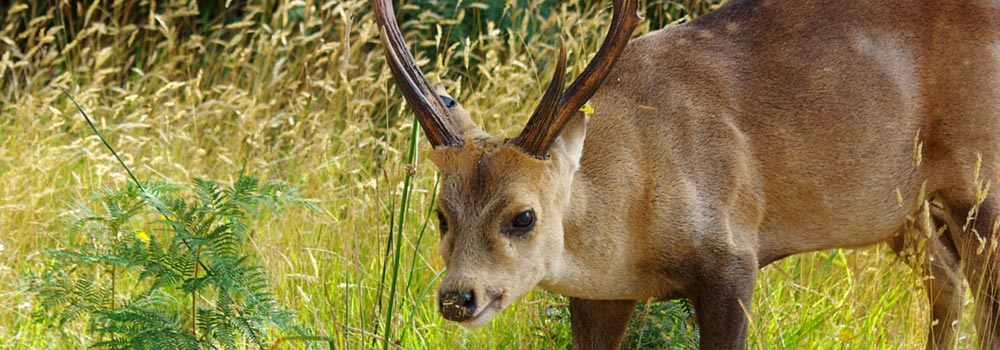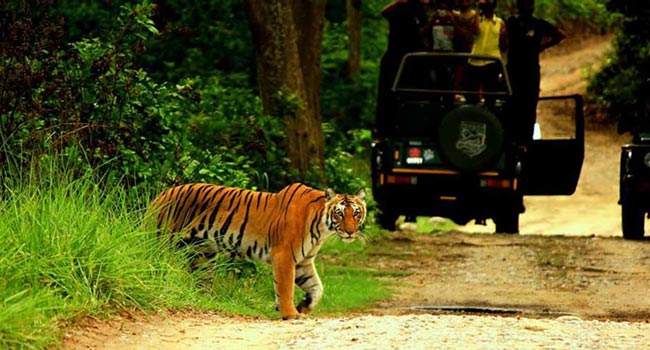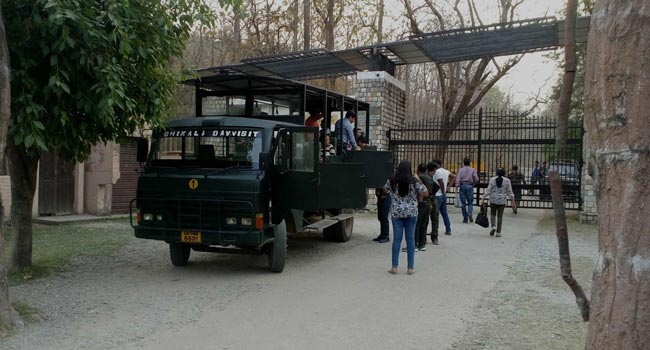Flora & Fauna

Flora
The Jim Corbett National Park is blessed with the natural bounty in the form of distinct flora which comprises of fresh water flora and alpine flora. Extent over an area of more than 521 square kilometers the Corbett has diverse floral count that is absolutely astonishing. The various habitat types of Corbett is occupied by Sal forests, Khair-Sisso forests, Mountains, Chaur, and rivers and streams that owes their distinct assemblage of plants. According to botanical survey of India Corbett has 600 species of plants - trees, shrubs, ferns, grass, climbers, herbs and bamboos. These many distinct varieties of plant kingdom makes the national park sought after wildlife destination for those who wish to relax from hectic schedule of working throughout the year.
Trees
The most visible trees found in Corbett are sal, khair and sissoo (see Habitats and Ecosystems). Many other species that contribute to the diversity, are found scattered throughout the park.All bamboos in a forest flower together at the same time once in several decades. After flowering, fruiting and dispersal of seeds, all individuals die together.
Chir pine (Pinus roxburghi)
Chir pine is the only conifer of the Park and is found on ridge-tops like Chir Choti but comes quite low in Gajar Sot. The upper reaches near Kanda have Banj Oak (Quercus leucotrichophora) growing which is essentially a Himalayan species.
Palms
include Khajur or Date-palm (Phoenix sp.) that occurs in open areas. Wallachia densiflora is a rare palm characteristic of Eastern Himalayas but is found in Corbett near Sultan. Kanju (Holoptelia integrifolia), Jamun (Syzygium cumini) and Aamla (Emblica officinalis) are found scattered throughout the lower areas while Tendu (Diospyros tomentosa) occurs in moist areas. Other major tree species are Bel (Aegle marmalos), Kusum (Schleichera oleosa), Mahua (Madhuca indica) and Bakli (Anogeissus latifolia).
Flowering trees
lend colour to the forests in Corbett. The main ones are Kachnaar (Bauhinia variegata) with pink to white flowers, Semal (Bombax ceiba) with big red blooms, Dhak or Flame-of-the-forest (Butea monosperma) with bright orange flowers, Madaar or Indian Coral (Erythrinia indica) with scarlet red flowers and Amaltas (Cassia fistula) with bright yellow chandelier like blooms. Some species of trees that do not occur naturally in the Park have been artificially planted in and around habitation. These include Teak (Tectona grandis), Eucalyptus, Jacaranda (Jacaranda mimosaefolia), Silver Oak (Gravillea robusta) and Bottlebrush (Callistemon viminalis), and can be seen in and around forest rest houses.

Hurbs
Herbs include many species of wildflowers belonging mostly to Pea and Aster families. They are most visible on grasslands or chaurs and on open areas. Drymaria diandra is a spreading annual herb with heart shaped leaves and occurs in moist shady places. Bhilmora (Rumex hastatus) is a sour tasting herb used for making chutney. Other species encountered in Corbett are Euphorbia hirta, a hairy herb, Indigofera liniofolia with bright red flowers, Clover (Oxalis sp.) with three leaflets, Solanum sp. and Leonotis nepatafolia (orange flowers and spiky round fruits).
Grasses
Corbett has over 70 grass speciesGrasses form the largest group of plant species in Corbett with more than 70 species recorded. They occupy different habitats, especially chaurs. They include Kansi (Saccharum sp.), Themeda arundinacea, Baib or Bhabar (Eulaliopsis binata), Narkul (Arundo donax), Tiger Grass (Thysanolaena maxima), Khus Khus (Vetiveria zizanioides), Cymbopogon flexuosus (a tufted grass with pleasant aromatic leaves), Aristida cyanantha (found amidst boulders), Neyraudia arundin acea (with light brown inflorescence) and Heteropagon contortus (Spear Grass with conspicuous sharp blades that adhere to clothes and penetrates skin).
FAUNA
Corbett National Park is home for many wonderful as well as endangered species of animals. The natural bounty and vast landscapes provide perfect habitat for wildlife here. The park plays a dutiful shelter in preserving a variety of flora count.The park is an ideal home for many majestic animals like the Royal Bengal Tiger, Asiatic Elephant and many other wild animals. Due to healthy population of wild today, Corbett is one of best preserved parks with 164 numbers of tigers and over 600 elephants. As per the recent survey Corbett reveals the highest density of population of tigers in the country at 20/100 square kilometers. Apart from Royal Bengal Tiger Corbett is also a home to a sizeable population of the endangered Asiatic elephant and other critically endangered species including the Ghariyal. Some of the other known mammal species reside in Corbett include Asiatic Black Bear, Hog Deer, Walking Deer, Sambar, Sloth Beer, Yellow-throated marten, Otters and many more to list.
Tiger
Corbett has one of the highest densities of tigeINR The tiger (Panthera tigris) is perhaps the most celebrated of the wild animals of India. It is symbolises the power of Nature and finds an important place in our culture, mythology and legends. It has been worshiped as the guardian and ruler of the forest. Tigers are believed to have evolved in East Asia (China) about 2 million years ago. They then dispersed to other parts of Asia. There existed eight subspecies of tiger, out of which three have gone extinct. Today this perfect carnivore is a critically endangered species, though once it roamed freely in most of Asia. India is home to the largest population of wild tigers in the world. There are estimated to be only 5000 to 7500 tigers surviving in the world. Out of these, the subspecies found in the Indian subcontinent, the Bengal tiger has 3000 to 4500 surviving members, more than three-fourths of which are in India.
The terai-bhabar region, including Corbett, was once the best place to find tigers but this habitat has reduced tremendously due to development-induced land use changes. The tiger has always had a close association Corbett National Park – earlier through the writings of Jim Corbett and other shikaris and later because of the launch of Project Tiger, India’s tiger conservation programme, initiated from the Park’s soil on 1st April 1973. Tigers hunt deer (preferably sambar but also chital and barking deer) and wild boar. They choose the largest of the prey species since larger prey represents more energy for the effort spent. For this reason the sambar population density is believed to be a good indicator of the presence of tigeINR Occasionally, tigers will also attack young of elephants and take smaller species, including monkeys, birds, reptiles and fish.
The Asian Elephant
The elephant, largest of the land mammals, has been an integral part of the history, mythology, tradition, culture and religion of India. There are three surviving species of elephants in the world, one in Asia and two in Africa. The Asian elephant (Elephas maximus) is distributed in the Indian subcontinent and Southeast Asia. Unlike the African species, Asian elephants have been domesticated for thousands of years and have been used in medieval warfare, for temples, and as a working animal.
A herd of wild elephants in a chaurThe Asian elephant was once found throughout south and southeast Asia but now it has been reduced to several scattered populations because of human activities like conversion of forest areas to farming, construction of dams and civil works like roads and canals. Apart from habitat constriction, these wide-ranging animals also face obstruction of their traditional migration routes. Poaching of elephants for ivory is another serious problem that elephants face.

Para or Hog Deer
(Axis porcinus) is the rarest of Corbett's deer. It is closely related to the chital but is smaller in size. Unlike most other deer, the hog deer is not given to leaping over obstacles but instead, it escapes its predators by crouching low, ducking under obstacles. Its limbs are short and its hind legs are longer than the fore legs. This anatomy raises its rump to a higher level than the shoulders.

Other mammals
The Leopard (Panthera pardus) is the other large cat found in Corbett. Compared to the tiger leopards are smaller, more graceful and have a long agile body that has rosettes instead of stripes. It also has the ability to limb trees. Leopards are quite versatile, adaptable to a variety of terrains as well as to a broad range of prey that includes everything from insects and rodents up to large ungulates. Leopards mostly hunt during twilight hours and at night. They also ambush their prey by jumping down from trees.

Jeep Safari Booking
Rate: ₹ 5500 / Jeep
Max People: 6 / Jeep
Time: 5:30 am-9:30 am | 2:00 pm-6:00 pm
Departure: Ramnagar
Availability: Round The Year

Elephant Safari Booking
Rate: ₹ 3500 / Elephant
Max People: 4 / Elephant
Time: 6:00 am 8:00 am | 4:00 pm- 6:00 pm
Departure: Ramnagar
Availability: Round The Year

Canter Safari Booking
Rate: ₹ 1700 / Person
Max People: 16 / Canter
Time: 5:30 am-11:30 am |1:00 pm-7:00 pm
Departure: Ramnagar
Availability: Round The Year
Online Safari Booking.
Book with us, Corbett's trusted tour operators.Copyright ©2023. Online Corbett Park Booking. All Rights Reserved

